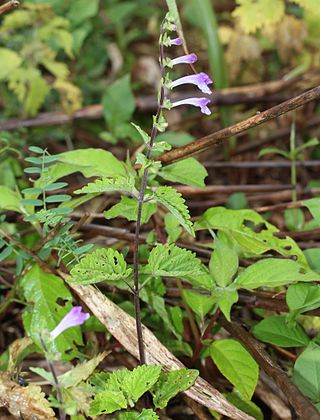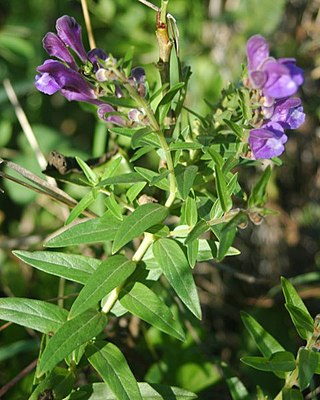
Scutellaria is a genus of flowering plants in the mint family, Lamiaceae. They are known commonly as skullcaps. The generic name is derived from the Latin scutella, meaning "a small dish, tray or platter", or "little dish", referring to the shape of the calyx. The common name alludes to the resemblance of the same structure to "miniature medieval helmets". The genus has a subcosmopolitan distribution, with species occurring nearly worldwide, mainly in temperate regions.

Scutellaria baicalensis, with the common name Baikal skullcap or Chinese skullcap, is a species of flowering plant in the family Lamiaceae.

As baicalin is a flavone glycoside, it is a flavonoid. It is the glucuronide of baicalein.

Baicalein (5,6,7-trihydroxyflavone) is a flavone, a type of flavonoid, originally isolated from the roots of Scutellaria baicalensis and Scutellaria lateriflora. It is also reported in Oroxylum indicum and Thyme. It is the aglycone of baicalin. Baicalein is one of the active ingredients of Sho-Saiko-To, which is a Chinese classic herbal formula, and listed in Japan as Kampo medicine.

Wogonin is an O-methylated flavone, a flavonoid-like chemical compound which is found in Scutellaria baicalensis.
Brachybacterium is a genus of Gram positive, nonmotile bacteria. The cells are coccoid during the stationary phase, and irregular rods during the exponential phase. The genus name comes from Greek word brachy, meaning short, and Latin bacterium, meaning rods, referencing the short rods noted during the exponential phase.
Brachybacterium alimentarium is a species of Gram positive, facultatively anaerobic, yellow-pigmented bacterium. The cells are coccoid during the stationary phase, and irregular rods during the exponential phase. It was first isolated from the surfaces of Beaufort and Gruyère cheeses in 1978. Further work led to the proposal of the new species in 1996, and the name is derived from the Latin alimentanium.
Brachybacterium tyrofermentans is a species of Gram positive, facultatively anaerobic, pale yellow-pigmented bacterium. The cells are coccoid during the stationary phase, and irregular rods during the exponential phase. It was first isolated from the surfaces of Beaufort and Gruyère cheeses in 1978, along with Brachybacterium alimentarium. Further work led to the proposal of the new species in 1996, and the name is derived from the Latin tyros (cheese) and fermentans (leavening), referring to the fermented cheese from which it was first isolated.
Brachybacterium aquaticum is a species of Gram positive, strictly aerobic, pale yellow-pigmented bacterium. The cells are coccoid during the stationary phase, and irregular rods during the exponential phase. It was first isolated from a seawater sample collected from the coastal region of Kovalam, India off the Indian Ocean. The name is derived from Latin aquaticum.
Brachybacterium fresconis is a species of Gram positive, strictly aerobic, cream-pigmented bacterium. The cells are coccoid during the stationary phase, and irregular rods during the exponential phase. It was first isolated from a medieval wall painting of the chapel of Schloss Herberstein in Styria, Austria. The species was proposed in 2014, and the name is derived from the fact it was first isolated from a fresco.
Brachybacterium ginsengisoli is a species of Gram positive, strictly aerobic, opaque bacterium. The cells are coccoid during the stationary phase, and irregular rods during the exponential phase. It was first isolated from soil in a ginseng field in Yeoncheon County, South Korea. The species was first described in 2014, and the name is derived from the Latin ginsengum (ginseng) and solum (soil).
Brachybacterium horti is a species of Gram positive, facultatively anaerobic, white-pigmented bacterium. The cells are coccoid during the stationary phase, and irregular rods during the exponential phase. It was first isolated from soil from a garden in the Guro District of Seoul, South Korea. The species was first described in 2016, and the name is derived from the Latin horti.
Brachybacterium huguangmaarense is a species of Gram positive, strictly aerobic, orange-pigmented bacterium. The cells are coccoid during the stationary phase, and irregular rods during the exponential phase. It was first isolated from a lake sediment sample from Huguangyan Maar Lake collected in Zhanjiang, Guangdong Province, China. The species was first described in 2014, and the name is derived from the location from which the organism was first isolated.
Brachybacterium muris is a species of Gram positive, strictly aerobic, yellow-pigmented bacterium. The cells are coccoid during the stationary phase, and irregular rods during the exponential phase. It was first isolated from the liver of a laboratory mouse. The species was first described in 2003, and the name is derived from the Latin muris (mouse).
Brachybacterium phenoliresistens is a species of Gram positive, facultatively anaerobic, yellow-pigmented bacterium. The cells are coccoid during the stationary phase, and irregular rods during the exponential phase. It was first isolated from oil-contaminated sand in Pingtung County, Taiwan. The species was first described in 2007, and its name refers to the species' ability to resist phenol. It is most closely related to B. nesterenkovii.
Brachybacterium sacelli is a species of Gram positive, strictly aerobic, cream-pigmented bacterium. The cells are coccoid during the stationary phase, and irregular rods during the exponential phase. It was first isolated from a medieval wall painting of the chapel of Schloss Herberstein in Styria, Austria. The species was proposed in 2014, and the name is derived from Latin sacelli. Another novel species B. fresconis was isolated from the same painting.
Brachybacterium saurashtrense is a species of Gram positive, strictly aerobic, halotolerant, pale yellow-pigmented bacterium. The cells are coccoid during the stationary phase, and irregular rods during the exponential phase. It was first isolated from roots of Salicornia brachiate plants collected from coastal marshy swamps, in Bhavnagar, Gujarat, India. The species was first proposed in 2011, and the name is derived from Saurashtra, the region where it was first isolated.
Brachybacterium squillarum is a species of Gram positive, strictly aerobic, halotolerant, yellow-pigmented bacterium. The cells are coccoid during the stationary phase, and irregular rods during the exponential phase. It was first isolated from salt-fermented seafood from South Korea. The species was first proposed in 2011, and the name is derived from Latin squillarum.
Brachybacterium zhongshanense is a species of Gram positive, facultatively anaerobic, halotolerant, cream-pigmented bacterium. The cells are coccoid during the stationary phase, and irregular rods during the exponential phase. It was first isolated from sediment along the Qijiang River, Zhongshan, China. The species was first proposed in 2011, and the name refers to the city from which it was first isolated.
Phycicoccus endophyticus is a species of Gram positive, strictly aerobic, non-endospore-forming bacterium. The species was initially isolated from surface sterilized bark of a black mangrove tree collected from Zhanjiang Mangrove Forest National Nature Reserve in Guangdong, China. The species was first described in 2016, and its name refers to the endophytic nature of the organism.




